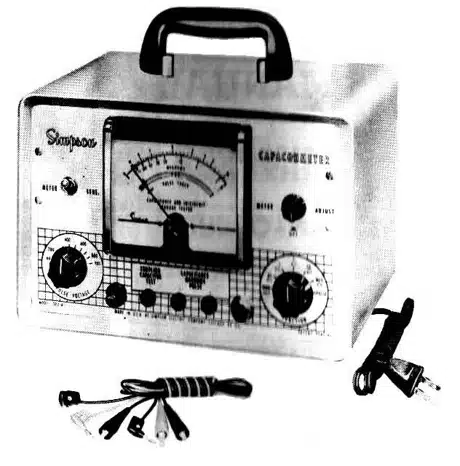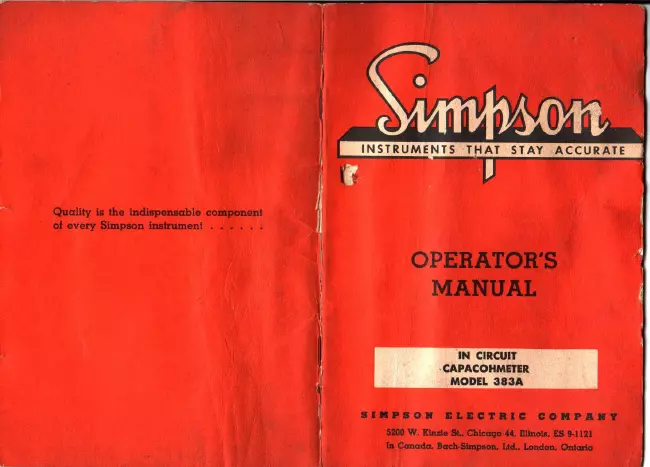Simpson - 383A - Other
Manufacturer:

Image 1 of 1
If you have any other photos or manuals for the
Simpson 383A
you can
upload the files here.
Equipment:
383A
Date:
1956
Category:
Group:
Sub Group:
Information
The Simpson Gtpacohmeter Model 383A is a combination of
three basic instruments into a single cabinet. These
instruments each perform a different type of test on
capacitors. All three work together to provide the most
conclusive series of capacitor evaluations available.
TYPES OF TESTS
MEASURING CAPACITANCE
One of the measurements which is essential for determining
the quality of a capacitor is its capacitance. The Simpson
Capacohmetcr Model 383A indicates capacitance on a
direct-reading meter scale· There are five ranges for
capacitance measurements from 10 micro-microfarads (MMFD) to
10 microfarad« (MFD). This wide range includes most ceramic,
mica, paper, oil-filled, and air dielectric types of capacitors.
measuring leakage resistance
A second* measurement which is of importance for evaluating
capacitors is the amount of leakage resistance. Ordinarily,
a Capacitor is assumed to have almost infinite resistance
between its two plates, or electrodes, Actually, there
i&;always some high resistance DC path between the plates
.because there is no such thing as a "perfect” insulate The
resistance of the DC path in a good capacitor is measurable
in megohms, so the Simpson Capacohmerer has a megohms
measuring circuit.
Deterioration and damages, both physical and electrical,
will reduce the original high leakage resistance to a lower
value during the life of the capacitor. The lower limit of
leakage resistance value at which the capacitor is still
usable depends on a number of factors.
There is no definite numerical value of leakage resistance
that can be assigned, wherein all capacitors having a higher
value of leakage resistance are GOOD, and those having lower
leakage resistance are BAD. Rather we must consider the
leakage resistance in relationship to the circuit containing
the capacitor in question.
Nevertheless, as a relative measurement, the megohms
indications are a wonderful aid in determining faulty
components.
The megohmmeter portion of the Simpson Capacohmeter may be
used separately to measure high resistance for many
applications other than capacitors. See Section IV for some
suggested applications.
PULSETESTING
Many capacitors will respond normally to the first two tests
which can be made with the Simpson Capacohmeter, and still
will not perform satisfactorily when they are placed in
service. This is true because the nature of the circuit into
which they are connected is very different from the testing
circuit. For the capacity measurement circuit, there is a
sine wave AC voltage which is applied to the capacitor. For
the megohms measurement, a DC voltage is applied to the
capacitor.
To complete the types of voltages which are applied for
testing, a narrow pulse voltage is applied from a relaxation
oscillator in the Simpson Capacohmeter, The amount of peak
voltage in the pulse is variable with a front panel control,
and the amount applied for each test is related to the
amount of voltage stress which the capacitor is rated to
withstand.
If the capacitor is in good condition, the application of a
safe value of pulse voltage will not affect it in any way.
But if the capacitor is weak, or is about to become
defective, the pulse voltage will cause an internal change
in the capacitor which will change the meter indication,
IN-CIRCUIT CHECKS
Most installed capacitors can be checked without removal
from their circuity. This is a distinct advantage over
previous testing procedures which require that the capacitor
be isolated from i lie circuit by unsoldering a lead. The
limitation on this use is the case where a capacitor is in
parallel with a low resistance or low reactance component.
However, with the Model 383A, most capacitors can be tested
without any unsoldering or clipping of leads. This facility
is of particular value in checking printed circuits and
plated circuits.
For convenience, there is a special circuit, requiring the
third lead on the Capacohmeter, for testing coupling
capacitors without removal from the circuit. The controlled
voltage is injected on the input side of the coupling
capacitor circuit, and the results are measured on the
output side of the capacitor.
1 Manual
Service and user manual
Manual type:
Service and user manual
Pages:
22
Size:
1.1 MB
Language:
english
Revision:
Manual-ID:
Date:
Quality:
Scanned document, reading partly badly, partly not readable.
Upload date:
Nov. 22, 2014
MD5:
c43cdc66-fc21-53e7-ec19-63ec63960352
Downloads:
588
